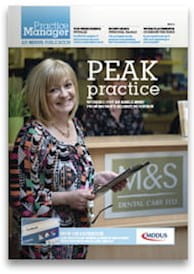
PRESCRIBING errors constitute one of the top risk areas for general practice and every year account for around 13 per cent of all GP negligence claims reported to MDDUS.
In 2012, the GMC commissioned a study which found that one in 20 prescriptions had either a prescribing or monitoring error. Even more concerning, they found that one in 550 of all prescription items contained an error judged to be severe. Many errors are picked up before the patient is harmed, however when harm does occur, it can be serious and long-lasting.
At MDDUS, there is ongoing analysis of how claims of negligence arise as a result of failures in prescribing. Some claims arise due to a prescriber neglecting to stay up-to-date or through a lack of awareness of current, evidence-based practice. However, the remainder of causes can be grouped into the five categories discussed below. Risk levels in these categories can be reduced by good management of prescribing systems and ensuring adequate training and competence of the non-clinical staff who support these systems.
MEDICINE REVIEW
Here failures arise primarily as a result of the prescriber or practice team not fully utilising the patient record system effectively. This can mean that information "pushed out" when a patient requests a prescription is unhelpful and so ignored.
When a medicine is prescribed, the clinician is responsible for ensuring that appropriate reviews are undertaken. If review periods are not entered appropriately, short and long-term reviews of medicines are not triggered and therefore not actioned. This can lead to over-prescribing and continued prescribing in cases where a patient requires testing or review – both of which can result in significant patient harm and a potential claim for negligence. Reviewing medicines is particularly important where:
- the patient may be at increased risk, for example if they are frail or have more complex clinical conditions
- the medicine has potentially serious or common side-effects either on its own or when being used in conjunction with other drugs
- the patient is prescribed a controlled drug or other medicine that is commonly abused or misused
- the BNF or other authoritative clinical guidance recommends blood tests or other monitoring at regular intervals.
Action: It is important that appropriate review periods are added to the prescribing system and that subsequent alerts are actioned – or at least flagged for clinical review.
PRESCRIPTION ERROR
The second largest group of claims are caused by a prescribing error, such as with confusion over a drug name or dosage. The majority of these arise as a result of human errors in using computerised prescribing systems with drop-down lists to select drugs which may have similar names but very different properties. Recent examples include the prescribing of lofepramine hydrochloride (an antidepressant) instead of loperamide hydrochloride (an anti-diarrhoeal), olanzapine (anti-psychotic) instead of omeprazole (a proton pump inhibitor) and fluoxetine (an anti-depressant) instead of fluclomix (an antibiotic).
Action: Highlight the risks of such errors to prescribers and those delegated to prescribe on their behalf to ensure extra vigilance.
RECONCILIATION OF MEDICINES
The majority of these claims arise when responsibility for prescribing is transferred back to the practice after the patient has spent some time as an inpatient in hospital. It is thought that between 30 and 70 per cent of patients experience a medication error during this transition.
Even within your own practice there may be different systems in place. Many doctors recognise the complexities and risks associated with the task and so prefer to make changes themselves. Some will delegate the task to administrative staff and the delegation process (including judgments about the team member’s competence and awareness of risks) are important here. Clinicians make mistakes too but it looks even worse – if an adverse event occurs and a patient harmed – when they have delegated the task and, importantly, not checked the outcome, particularly when the process of delegation has been poorly managed.
Action: Review prescriber practices within your own team. If delegation occurs, ensure there is effective training in place which includes checks of competence. Make sure prescriber instructions to non-clinical staff are clear, and that there is a clinical review of the prescribing records before issuing repeats.
Undertake risk management of your practice systems – involve the whole team as this raises awareness and reduces the risks of individuals "doing things differently".
KNOWN ALLERGY
A common error here is when the allergy is recorded as free text in a prescribing system and not coded: for example adding "allergy to trimethoprim" as a free-text entry and not specifically coding "trimethoprim allergy". The consequences of a drug allergy can range from a mild rash to anaphylaxis and anything in between.
A recent case involving a known trimethoprim allergy caused the patient to experience a disturbing reaction with the letter of claim noting that the patient experienced: "severe bleeding of the skin on both sides of her face and neck and initially some difficulty with breathing. The patient also lost her eyesight for just over a week – which was terrifying as you might imagine".
Action: Ensure known allergies are coded appropriately to generate prescribing alerts. Ensure prescribers check verbally with the patient that they have no known allergies as a "safety net".
CONTRAINDICATIONS
Prescribing when medicines are contraindicated, either because the patient is on a medicine which could cause an adverse interaction or because the patient has a medical condition which could be worsened by the new medicine, is sometimes necessary but needs frequent monitoring.
Use of system coding of medical conditions to ensure accurate alerts are available is important. When a medicines alert arises, a clinician should be the one to override this. It is important to record the risks of using a contraindicated drug in the patient’s notes, be able to justify the reasons and demonstrate that risks versus benefits of doing so have been considered.
Commonly, risks occur when admin staff override an alert when they have been delegated the task of adding medicines, with the assumption that "the GP would’ve already been aware of, and considered, the interaction”". Often, it is important that the patient is monitored more carefully and so the patient should be added to a robust call/recall system to ensure this does not get overlooked. If a patient defaults from review, staff should check the impact of this with the prescriber to ensure recall is escalated if necessary.
Actions: Clinical conditions should be coded appropriately so that relevant alerts are generated. These alerts should only be over-ridden where they have been clinically reviewed.
REVIEW THE FOUNDATIONS FOR SAFE PRACTICE
Consider your practice’s relationship with local pharmacies. A good relationship with a pharmacist (for both the practice and the patient) can be very beneficial. Being approachable when it comes to prescription "queries" (rather than offering a brusque "what is it now?") can provide an additional safety net.
Undertake risk management of your practice systems – involve the whole team as this raises awareness and reduces the risks of individuals "doing things differently". MDDUS risk checklists can help. Ensure that when things do go wrong – or there is a near miss – the incident is reported and that you engage proactively in significant event analysis (SEA). This will assist in demonstrating reflection and learning from an incident where appropriate.
ENGAGING THE TEAM
Episode three of our MDDUS drama series, Bleak Practice, provides the opportunity to watch with your team as some of the most common prescribing errors unfold, whilst using the associated team discussion guide to consider the impact of your own practice’s systems of working on levels of risk. Access the video module in the Risk Management eLearning centre at www.mddus.com.
Liz Price is a senior risk adviser at MDDUS
This page was correct at the time of publication. Any guidance is intended as general guidance for members only. If you are a member and need specific advice relating to your own circumstances, please contact one of our advisers.
Read more from this issue of Practice Manager

Save this article
Save this article to a list of favourite articles which members can access in their account.
Save to library